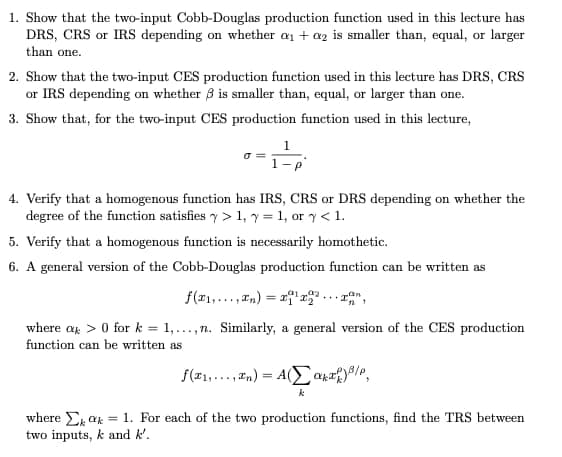1. Show that the two-input Cobb-Douglas production function used in this lecture has DRS, CRS or IRS depending on whether a + az is smaller than, equal, or larger than one.
1. Show that the two-input Cobb-Douglas production function used in this lecture has DRS, CRS or IRS depending on whether a + az is smaller than, equal, or larger than one.
Chapter10: Cost Functions
Section: Chapter Questions
Problem 10.9P
Related questions
Question
Q1
and ignore lecture info,,...
you do it

Transcribed Image Text:1. Show that the two-input Cobb-Douglas production function used in this lecture has
DRS, CRS or IRS depending on whether an + az is smaller than, equal, or larger
than one.
2. Show that the two-input CES production function used in this lecture has DRS, CRS
or IRS depending on whether 3 is smaller than, equal, or larger than one.
3. Show that, for the two-input CES production function used in this lecture,
4. Verify that a homogenous function has IRS, CRS or DRS depending on whether the
degree of the function satisfies y > 1, y = 1, or y < 1.
5. Verify that a homogenous function is necessarily homothetic.
6. A general version of the Cobb-Douglas production function can be written as
сan
f(r1,..., In) = x'r ...
where a > 0 for k = 1,...,n. Similarly, a general version of the CES production
function can be written as
f(#1,... , In) = A(Eapr9/°,
where E ar = 1. For each of the two production functions, find the TRS between
two inputs, k and k'.
Expert Solution
This question has been solved!
Explore an expertly crafted, step-by-step solution for a thorough understanding of key concepts.
This is a popular solution!
Trending now
This is a popular solution!
Step by step
Solved in 5 steps with 6 images

Knowledge Booster
Learn more about
Need a deep-dive on the concept behind this application? Look no further. Learn more about this topic, economics and related others by exploring similar questions and additional content below.Recommended textbooks for you


Managerial Economics: Applications, Strategies an…
Economics
ISBN:
9781305506381
Author:
James R. McGuigan, R. Charles Moyer, Frederick H.deB. Harris
Publisher:
Cengage Learning



Managerial Economics: Applications, Strategies an…
Economics
ISBN:
9781305506381
Author:
James R. McGuigan, R. Charles Moyer, Frederick H.deB. Harris
Publisher:
Cengage Learning



Microeconomics: Principles & Policy
Economics
ISBN:
9781337794992
Author:
William J. Baumol, Alan S. Blinder, John L. Solow
Publisher:
Cengage Learning
